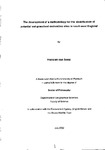The development of a methodology for the identification of potential wet grassland restoration sites in south west England
| dc.contributor.author | van Soest, Francien | |
| dc.contributor.other | Faculty of Science and Engineering | en_US |
| dc.date.accessioned | 2013-09-16T11:04:53Z | |
| dc.date.available | 2013-09-16T11:04:53Z | |
| dc.date.issued | 2002 | |
| dc.identifier | NOT AVAILABLE | en_US |
| dc.identifier.uri | http://hdl.handle.net/10026.1/1748 | |
| dc.description.abstract |
Large scale drainage and pasture improvement in the past and present-day neglect of the floristically diverse wet grasslands in south west England have caused a significant decrease, approximately 92% since 1900. in the total area of this ecologically valuable semi-natural plant community. The plant community, which is locally called Culm grassland, consists of acid purple moor grassland, soft rush meadows and wet heaths. Conservation and restoration of these grasslands requires careful planning and efficient use of resources. This study was aimed at developing strategies for regional planning authorities and nature conservation agencies and developed a management tool for the selection of potential Culm grassland restoration locations and for the prediction of species composition based on the environmental characteristics of a site. Three separate sections of the research could be distinguished. The first section studied the relationships between the wet grassland location and the landscape topography, catchment hydrology and soil physical characteristics, with the use of Geographical Information Systems. Landscape topography was expressed as the ln(a/tan^) topographic index, in which 'a' is the upslope area draining through the point for which the index is calculated and 'fi' is the local slope angle. Culm grassland sites were generally found on positions with a topographic index larger than eight. A quantification of soil saturation periods was carried out by modelling the surface water dynamics with the hydrological model TOPMODEL, which was based mainly on the topographic index. Soil hydrological characteristics were described by applying the Hydrology Of Soil Types (HOST) classification to the soil map of the area. Results indicated that Culm grassland was mainly associated with poorly drained soils and topographic hollows on level or gently sloping grounds. The second section investigated the species composition In relation to environmental parameters and grazing regime. A field study involving collection of vegetation, soil and site data was carried out on existing Culm grassland sites. Multivariate statistical techniques were applied to relate vegetation gradients to the environmental parameters. Results showed that grazing pressure, soil pH and soil water were the factors most responsible for species composition within the Culm grassland communities. The third section integrated the results into a decision support system, which indicated where potentially suitable restoration sites were located and the species composition that could develop based given the environmental parameters. The procedure was tested by application of the decision rules to an independent area and comparison of the potentially suitable sites to historical data, field observations and land use information. From this study, given readily obtainable soil and topographic data a, good first selection of areas for further Culm grassland development could be made. However, relationships between vegetation and environmental parameters will need more detailed field investigation to obtain completely reliable results. | en_US |
| dc.description.sponsorship | Environment Agency, English Nature and the Devon Wildlife Trust | en_US |
| dc.language.iso | en | en_US |
| dc.publisher | University of Plymouth | en_US |
| dc.title | The development of a methodology for the identification of potential wet grassland restoration sites in south west England | en_US |
| dc.type | Thesis | |
| plymouth.version | Full version | en_US |
| dc.identifier.doi | http://dx.doi.org/10.24382/4819 |
Files in this item
This item appears in the following Collection(s)
-
01 Research Theses Main Collection
Research Theses Main


